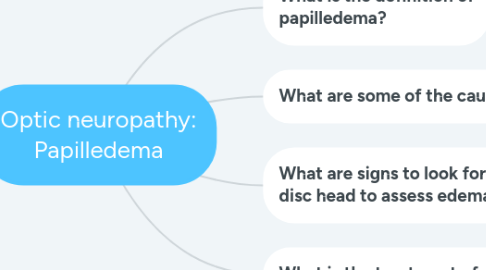Optic neuropathy: Papilledema
por Eduardo Mayorga


1. What is the definition of papilledema?
1.1. Papilledema is optic disc swelling due to increased intracranial pressure.
2. What are some of the causes of papilledema?
2.1. Tumor
2.2. Venous sinus thrombosis
2.3. Drugs
2.3.1. What are some of the medications that cause increased ICP?
2.3.1.1. Tetracycline, minocycline, vitamin A, lithium, corticosteroids
2.4. Sleep Apnea
2.5. Meningitis
2.6. Idiopathic Intracranial Hypertension (IIH)
2.6.1. What are the diagnostic criteria for IIH?
2.6.1.1. Normal neuroimaging; increased ICP on LP; normal CSF
2.6.2. What are some symptoms of IIH?
2.6.2.1. Headache, transient visual obscuration, tinnitus, visual loss, diplopia
2.6.3. What are some signs of IIH?
2.6.3.1. Optic disc edema, peripapillary hemorrhages, Paton's lines, cranial nerve 6 palsy,
2.6.4. What are considered red flags/atypical IIH features?
2.6.4.1. male, age>49, normal BMI
3. What are signs to look for at the optic disc head to assess edema?
3.1. Blurring of the disc margins, elevation of the nerve, any capillary dilatation, absence/presence of venous pulsation
4. What is the treatment of papilledema?
4.1. fix the underlying problem (stop associated drug)
4.2. weight loss
4.3. start medications (acetazolamide, topamax, lasix)
4.4. surgery (CSF diversion, optic nerve sheath fenestration, bariatric surgery, venous sinus stenting)
4.4.1. When is it urgent to surgically treat?
4.4.1.1. Rapid or severe vision or visual field loss
4.4.1.1.1. What is the treatment in this case?
